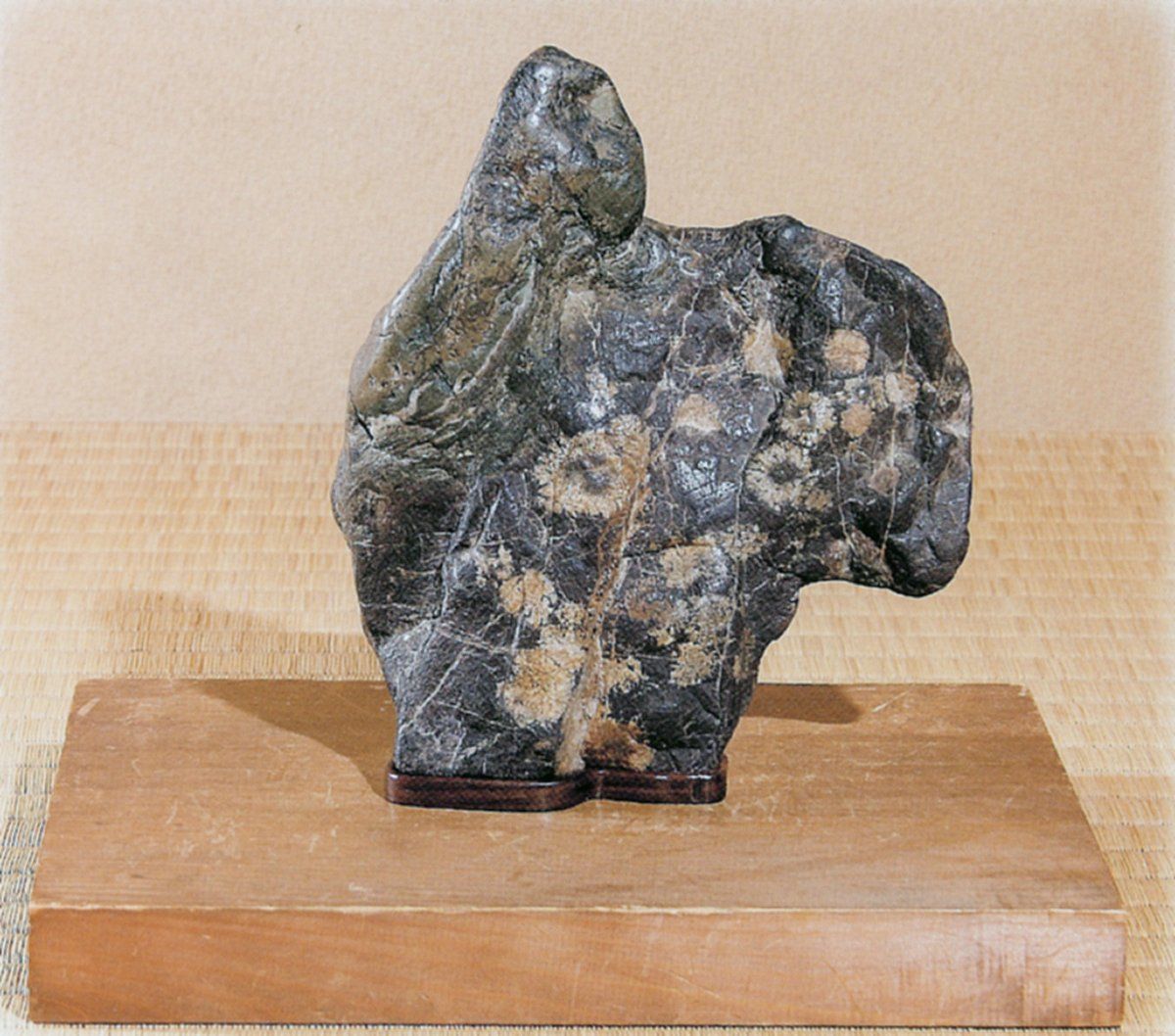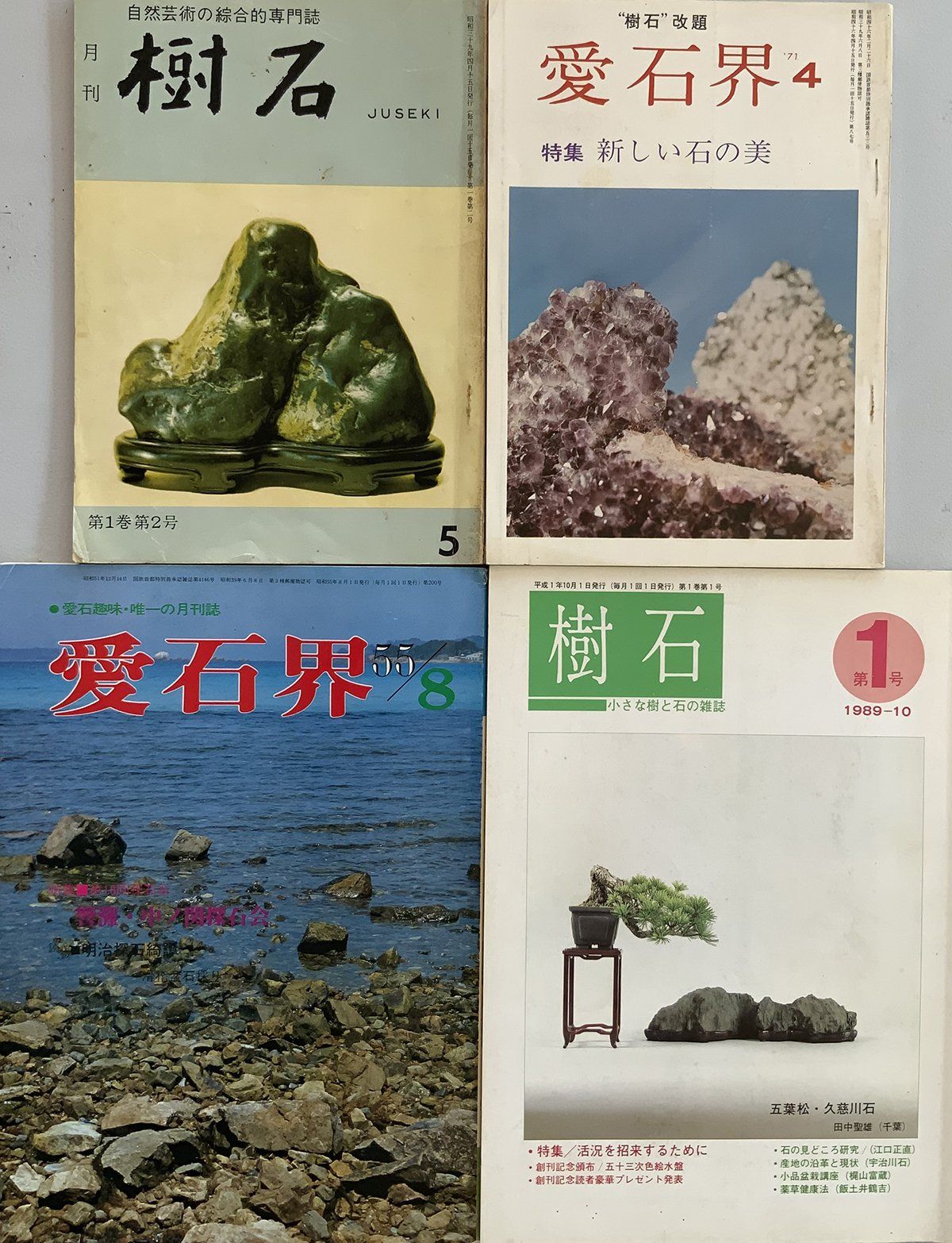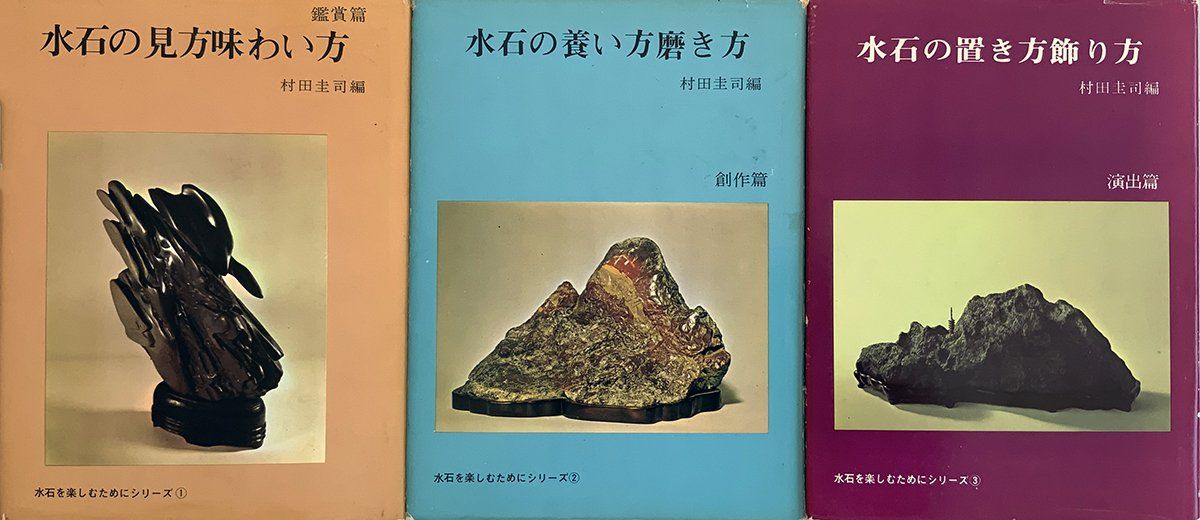The Murata Family’s Contribution to the Development of Japanese Suiseki
A comprehensive account of the contributions of the Murata family members to the popularization of suiseki in Japanese from the 1960 through the 1980s.
By Hiromi Nakaoji, July, 2021
The contributions of the Murata family—the patriarch Murata Riemon, his son Murata Kenji, and grandson Murata Keiji—significantly helped popularize suiseki between 1960 and the late 1980s. Murata Riemon and Murata Kenji were bonsai and suiseki dealers, while Keiji was a writer, editor, and publisher of books and numerous articles about bonsai and suiseki. Keiji, more than his father or grandfather, popularized suiseki through many publications, his promotion of exhibitions, and sale of quality suiseki and related tools.
The Murata’s family nursery, originally called Hanayashiki, was started in 1873 by Suzuki Magohachi (1840-1903), who was the father of Murata Riemon. The family name Suzuki was changed to Murata in Riemon Murata’s time. Later the nursery name was changed to Koju-en based upon a recommendation made by Kido Takayoshi, a well-known politician. Both Magohachi and Riemon had many rich and famous customers, but they both concentrated on the business aspects of the nursery, rather than stylizing bonsai.
Murata Keiji’s book Modern Suiseki Photobook was published by his company Koju-en in 1963. During the 1960s, the Murata family fueled the growing interest in stone appreciation by publishing nineteen books on Suiseki.
Murata Riemon (1864-1936) played an essential role in the development of bonsai in Japan. He organized the “Bonsai Club” that held a monthly exhibit of bonsai and published “Bonsai Gaho” as the club magazine in April 1906. “Bonsai Club” was the first monthly bonsai magazine in Japan, selling over 3,000 issues monthly. All the subscribers were members of the club. Publication of the magazine lasted 11 years; the last issue was #139. After the Great Kanto Earthquake in Tokyo in 1923, he helped the recovery of bonsai in Tokyo. In cooperation with other bonsai nurseries in Tokyo, Riemon set up the Great Japan Bonsai Encouragement Club and held an exhibit. This exhibition led to the publication of the magazine “Bonsai,” with Kobayashi Norio serving as a chief editor for the following 40 years.
Murata Riemon established the Tokyo Bonsai Alliance in 1933, with Kobayashi Norio and others. Riemon served as the first president of this new alliance. This organization later became the Nippon Bonsai Alliance, then the Nippon Bonsai Cooperative.
Murata Kenji (1901-1992) became the third head of Koju-en in 1936 after his father passed away. Kenji was active both in bonsai and suiseki, and he published and supervised many books on bonsai and suiseki. Kenji also assisted stone collectors in naming their stones and having storage boxes (Kiri Bako) made for their better stones. In addition, he was one of the founding members of the Nippon Suiseki Association in 1961.
This stone was collected by Ogasawara Mitsuo on June 25, 1971 in the Ishikari River at Kamuikotan in Hokkaido. Ogasawara sent this stone to Murata Kenji to assign a poetic name and have a Kiri-bako (storage box) made for this stone since Murata was a recognized leader in Japanese suiseki. Kenji named this stone “Spring” because it reminded him of a fresh water spring. The correspondence between Ogasawara and Murata is kept in the storage box.
Kenji was interviewed in the August 1990 issue of Juseki magazine. In this interview, perhaps the last one in his life, he mentioned that suiseki was popular only among a specific class of people until the First Japan Suiseki Masterpieces Exhibition in 1961 at the Mitsukoshi Department Store in Tokyo. The exhibition was held at the time of the establishment of the Japan Suiseki Association. The first public exhibition at a famous department store helped to interest the general public in suiseki. About 200 stones were displayed, and the catalogs of the exhibition sold out. One of the historically important ‘Kurokami-Yama (Black hair mountain)’ suiseki was displayed at the occasion. This exhibition was, for Kenji, the beginning of the popularization of suiseki.
In addition to many publications, Kenji was well-known for introducing ‘Hagoromo’ stone to the suiseki world. Hagoromo is a small natural, perhaps river-washed chrysanthemum stone from Neo Valley in Gifu prefecture. Around 1947 when he visited Dr. Shiraki Koichi, a chrysanthemum stone mountain owner and collector, Kenji acquired the Hagoromo stone after many requests to Dr. Shiraki. When Kenji got the stone, he asked Hibino Ikkansai, an excellent artisan, to make a base. Ikkansai did not take the job lightly, and he wanted time to think of the base for the stone. When he came up with the idea, he agreed to make a base; he made not only a base, daiza, but a stage with a cypress jiita for the Hagoromo stone. The jiita served as a Noh play stage. Later the scroll painted by Ikegami Shuho (1874-1944), a famous Japanese-style painter, was added. In the late 1990s, the Hagoromo stone set with a scroll was said to be sold for $700,000.
Japanese chrysanthemum flower river washed (kawa zure) stone named “Hagaroma” and promoted by Murata Kenji. This small stone together with it base, stage and scroll may be the most expensive chrysanthemum flower stone ever sold in Japan.
Murata Keiji (1926-1989) was the first son of Kenji Murata. Had he not died many years before his father, he probably would have taken over the family business of running the bonsai nursery. His accomplishments were many. He started the Juseki Company in 1964 to publish the monthly magazine Juseki (trees and stones) and books on stones. The first issue of the magazine was published in May 1964. The magazine was renamed Aiseki-kai (Aiseki World) with the April 1971 issue. The intent of changing the name of the magazine was to broaden the scope of the magazine to cover Biseki (beautiful stones), Chinseki (Chinese stones), fossils, minerals, abstract stones, and garden stones.
Aiseki-kai magazine published its 200th issue in August 1980. In that issue, Yamamoto Goro, the chief editor of the magazine, wrote an article to reflect his work at the Juseki Company with Murata Keiji. Yamamoto wrote that suiseki in 1980s Japan became subordinate to bonsai, and there were many people who talked about the theories of suiseki. Stone hunting in Japan became more popular, rather than the purchase of stones from dealers.
The Juseki Company, headed by Keiji, published Aiseski-kai magazine until the end of 1981. During the years, Murata Keiji served as the president of the Juseki Company, and as the magazine’s chief editor, he wrote many of the articles.
Aiseki-kai magazine began to be managed and published by the Aiseki-kai Company starting in January 1982. Keiji decided to part ways with Aiseki-kai magazine because he saw the saturation of the sales of the suiseki magazine and decided to publish Bonsai Sekai (Bonsai World) in 1980. Bonsai became the main hobby among the general public in the 1980s in Japan. After Keiji left, the Aiseki-kai magazine continued to be published until the last issue in December 1988.
Suiseki magazines published or edited by Murata Keiji: Upper left, Juseki’; upper right Aiseki-kai; lower left, the 200th issue of Aiseki-kai; and lower right New Juseki Magazine (1989).
A group of Murata Keiji’s friends started the New Juseki Company later in 1989 to publish the new Juseki magazine in October 1989. Murata Keiji returned to take the position of chief editor for the magazine. It must have been an exciting opportunity for him. He wrote about his hopes and thoughts in the first issue as follows:
“I like to make this Juseki with articles to motivate readers to start suiseki hobby or more into the hobby. Our time is rapidly changing. Long-lasting peace, economic prosperity, and cultural development enriched our lives in Japan. As a result, people can enjoy a variety of hobbies. A single concept cannot lead to everything. Bonsai and suiseki have been evolved on the traditions. We can see the achievements of our ancestors. We should not lightly take the traditions since the present time does not exist without the traditions. Yet, the traditions are not enough for us to move forward. The traditions may stop us from moving forward along with time. Monthly Juseki magazine would like to appreciate old and good traditions, and at the same time, would like to respond to the diversity of the present day. I am not sure how much I can accomplish, but I would like to try.
…I hope this magazine will help new people understand the world (of stone appreciation). I believe as a chief editor that my role is to present issues and problems. Solutions will depend on the readers.”
Keiji had such high expectations and hopes for the new magazine. However, Keiji suddenly passed away in December 1989 with heart failure. In February 1990, two suiseki exhibits were held in Tokyo to commemorate Murata Keiji. Juseki #5 issue was a special issue dedicated to Keiji.
Murata Keiji authored, co-authored, and edited at least 30 books on suiseki. The Juseki Company published additional books on Japanese stones by other authors, but documenting his books on bonsai is beyond the scope of this article. All the books by Murata Keiji were in Japanese. The first book “Modern Suiseki Illustrated” was published in 1962.
A series of three Japanese language “How to” books edited by Murata Keiji and published in 1966 for people new to Japanese suiseki to learn about the stone appreciation practices.
During the 1960s, Keiji published 3 volumes on suiseki: How to View and Appreciate Suiseki, How to Cultivate and Polish Suiseki, and How to Place and Display Suiseki. He also published at least three additional books as an introduction to suiseki. Keiji published “Stones, the Beauty of Suiseki,” in 1974 which began to show his more refined thinking about suiseki. Then, in 1989, his final book “The Beauty and Heart of Suiseki,” was published with a limited issue of 350 copies. This book reflected his deep understanding of the art of suiseki.
Fortunately, Sekine Keiji, the president of New Juseki Company, published the entirety of The Beauty and Heart of Suiseki in the Juseki magazine between the 2008 February issue and the 2009 February issue. The contents of the book are as follows:
Part 1: Discussions and Thoughts
My view on the way of suiseki
Thoughts and observations on suiseki hobby
Thoughts on the origins of suiseki
The meaning of naturalness
Part 2: History
Overview of Aiseki history
Modern Japan Aiseki history
Retrospection of stone boom
Murata Keiji’s thoughts in part 1 of his final book inform us of his concern for the future of suiseki. He believed that new approaches of suiseki should be developed beyond the traditions, although he emphasized the value and importance of traditions. He expressed the danger of staying still and the importance of moving onward when suiseki hobbyists felt they reached the understanding of Wabi and Sabi in suiseki. Keiji thought the development and evolution of suiseki should be continually active, not stagnant.
Murata Keiji is one of the most significant persons in the modern history of Japanese suiseki. His greatest contribution was to popularize suiseki among the general public in Japan. However, he is not well-known outside Japan since none of his books is in English. Sen-en-kyo, the author of “Suiseki II,”’ one of the essential suiseki books written in Japanese and English in 2007, wrote “that nobody can study the Japanese history of bonsai and suiseki without referring to the contributions by Murata Kenji and Keiji.”
Notes:
All the names are Surname, given name in this order except Ikkansai. Ikkansai is an artist and he is referred as his first name. All the people in this article are male.
Following is a list of books I am aware of that were written or edited by Murata Kenji and Murata Keiji. The Juseki Company published additional works on suiseki by other authors, but those are not included here. All of the books listed below were published in Japanese. The titles and publication information are translated to English for the benefit of our VSANA readers.
Murata Kenji. Bonsai Pots and Susieki. Tokyo, Japan: Kashima Company, 1959.
__________, Supervised. Modern Suiseki Illustrated. Tokyo, Japan: Koju-en, 1962
__________. Suiseki, Everything about Landscape Stones. Tokyo, Japan: Juseki Company, 1962.
__________, Supervised. Modern Suiseki Illustrated. Tokyo, Japan: Koju-en, 1963
Takahashi Teisuke & Murata Keiji, Eds. Various Stories of Bonsai and Suiseki. Tokyo, Japan: Koju-en, 1962.
Murata Keiji, Ed. One Hundred People, One Hundred Stones: Hints for Stone Hunting. Tokyo, Japan: Tokuma Shoten, 1963.
Koju-en Publication, Ed. Stones of Sunen/Stones of Mino. Tokyo, Japan: Koju-en, 1964.
Murata Keiji & Takahashi Teisuke. For the Beginners of Suiseki. Tokyo, Japan: Ikeda Shoten, 1965.
Murata Keiji, Ed. How to View and Appreciate Suiseki, Appreciation Aspects, Book 1 of 3 Series. Tokyo, Japan; Juseki Company, 1963.
__________, Ed. How to Cultivate and Polish Suiseki, Creative Aspects, Book 2 of 3 Series. Tokyo, Japan: Juseki Company, 1966.
__________, Ed. How to Place and Display Suiseki, Staging Aspects, Book 3 of 3 Series. Tokyo, Japan: Juseki Company, 1966.
___________. Introduction to Suiseki. Tokyo, Japan: Ikeda Shoten, 1966.
Murata Kenji. Ed. Suiseki. Tokyo, Japan: Mokuji-sha, 1966.
Murata Keiji & Takahashi Teisuke, Eds. 1967. Color: The Beauty of Suiseki. Tokyo, Japan: Juseki Company, 1967.
___________ & Katsuno Tokiko. Dictionary of Stones. Tokyo, Japan: Tachikaze Shobo, 1967.
__________ _ & Maeda Kazu, Eds. Beautiful Stones and Rare Stones. Tokyo, Japan: Juseki Company, 1967.
Murata Kenji, Ed. Nippon Suiseki Excellently Illustrated. Tokyo, Japan: Juseki Company, 1969.
Murata Keiji. Suiseki Hobby Dictionary. Tokyo, Japan: Juseki Company, 1969.
Tanimoto Hyakusui & Murata Keiji, Eds. Furuya Excellent Stones Illustrated. Tokyo, Japan: Juseki Company, 1969.
Murata Keiji, Ed. Stones: The Beauty of Suiseki. Tokyo, Japan: Juseki Company, 1974.
Takeuchi Takema & Murata Keiji, Eds. Bonsai Pots and Suiban. Tokyo, Japan: Juseki Company, 1976.
Murata Kenji, Ed. 1977. Guidebook of Bonsai Pots. Tokyo, Japan: Juseki Company, 1977.
Murata Keiji, Ed. Suiseki: Poetic Feelings of Mountains and Waters. Tokyo, Japan: Juseki Company, 1981.
_________. Beauty and Heart of Suiseki. Tokyo, Japan: Japan Juseki Association Publishing Dept, 1989. (The second volume of Keiji’s life work. The first volume is a book on bonsai.)




